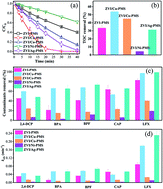Removal of contaminants by activating peroxymonosulfate (PMS) using zero valent iron (ZVI)-based bimetallic particles (ZVI/Cu, ZVI/Co, ZVI/Ni, and ZVI/Ag)†
Abstract
In this study, four different ZVI/M-PMS systems (e.g., ZVI/Cu, ZVI/Co, ZVI/Ni and ZVI/Ag) were fabricated to investigate the removal of contaminants (Rhodamine B (RB), 2,4-dichlorophenol (2,4-DCP), bisphenol A (BPA), bisphenol F (BPF), levofloxacin (LFX), and chloramphenicol (CAP)). The results indicated that ZVI/Cu and ZVI/Ag exhibited a superior performance to activate PMS compared with the ZVI. The mechanism of the investigation showed that a relatively positive correlation between the release of iron ions (Fe2+) and contaminant removal efficiency was found in different ZVI/M-PMS systems. This revealed that galvanic couples affected iron corrosion, and the ZVI/Cu and ZVI/Ag bimetallic systems facilitated the corrosion of ZVI but the ZVI/Co and ZVI/Ni bimetallic systems restrained the corrosion of ZVI. The electron paramagnetic resonance (EPR) analysis and the radical quenching experiments apparently supported the roles of the hydroxyl radical (˙OH), sulfate radical (SO4˙−) and superoxide radicals (O2˙−), which suggest that these reactive radicals were primarily responsible for the degradative route, and the contribution rate may follow the order of SO4˙− < O2˙− < ˙OH. Furthermore, investigation of crucial parameters showed that the contaminant removal ratio increased with an increase in the metal ratio (M : ZVI) to a certain limit, and a higher bimetal catalyst dosage and extremely acidic conditions (except for ZVI/Co, which showed the best catalytic performance under neutral condition) enhanced the degradation of contaminants. In the evaluation of real water samples, there was almost no influence from the water matrices compared to the control condition, and the ZVI/Cu and ZVI/Ag bimetallic particles showed great potential to treat various wastewater. Therefore, this study helps to understand the application of oxidation process based on bimetallic particles.



 Please wait while we load your content...
Please wait while we load your content...